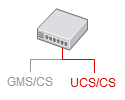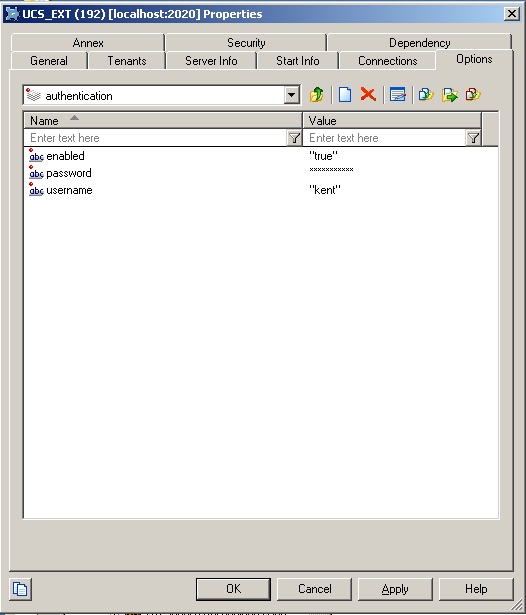Configuration Options

|
Purpose: Lists the configuration options that your application can read. |
Contents
Description
The tables in the following sections present the UCS configuration options that Context Services can read from the Configuration Layer:
- cview section—Options and values specific to Context Services.
- archiving section—Activates set-based archiving.
- authentication section—Enables and configures authentication control.
- log-filter section—Implements security log filtering.
- log-filter-data section—Also relates to security log filtering.
You can modify all these option values in the Configuration Manager. However, the change may not be effective immediately. For some options you have to restart UCS for changes to take effect (see the tables below).
[cview] Section
This section adjusts the overall configuration of Context Services.
| Name | Restart UCS<ref name="restart">This column indicates whether you must restart UCS for changes in the option value to take effect.</ref> | Description |
|---|---|---|
| enabled | Yes |
|
| base-url | Yes | The base URL used to deploy Context Services. Based on this configuration, the services are available at the following URL:
Where:
For example, if the ip-address is 192.168.1.1, the port 8080, and the base URL cms, the Set Server Mode operation would be available at the following URL: |
| ip-address | Yes | IP address used to deploy Context Services (localhost by default). |
| data-validation | No |
|
| start-mode | Yes | Start-mode of the server mode:
|
| tenant-id | Yes | Defaults to 101. Specifies the numeric tenant ID associated with Context Services: subsequent customer/contact records created through your application are associated with this tenant. |
| metadata-cache | No |
Important The cache contains metadata for contact attributes, identification keys, profiles, services, states and tasks extensions. |
<references />
[archiving] Section
This section activates and deactivates set-based archiving. It is not present on the UCS template; you must create it. It contains just one option:
| Name | Restart UCS<ref name="restart">This column indicates whether you must restart UCS for changes in the option value to take effect.</ref> | Description |
|---|---|---|
| use-np | Yes |
|
<references />
[authentication] Section
This section configures authentication for clients connecting to UCS. Authentication, available since release 8.0.300.02, applies to UCS/CS only. See also:
- The directly-related Basic Access Authentication page.
- Authentication on the Security and Authentication page.
| Name | Restart UCS<ref name="restart">This column indicates whether you must restart UCS for changes in the option value to take effect.</ref> | Description |
|---|---|---|
| enabled | Yes |
|
| mode | Yes | Authentication mode:
|
| password | Yes | Password to check the identity of the specified user. Effective only if mode is set to single-user. |
| username | Yes | User name allowed to connect to the Context Services API. Effective only if mode is set to single-user. |
| use-role | Yes |
|
<references />
[log-filter] Section
This section contains general settings for how or whether user data keys appear in the logs. Its settings can be overridden for specified keys by options in the log-filter-data section.
| Name | Restart UCS<ref name="restart">This column indicates whether you must restart UCS for changes in the option value to take effect.</ref> | Description |
|---|---|---|
| default-filter-type | No | Sets the default for filtering the output of user data keys to the UCS server log.
Possible values:
This default filter applies to all user data keys, except that is is overridden by any settings for individual keys in the log-filter-data section. |
| filter-depth | No | Depth used while filtering nested key-value pairs. The default is 99. Any value greater than this is not checked. Using a high value can result in lower performance in the case of deeply nested key-values. |
<references />
[log-filter-data] Section
This section enables you to override the log-filter section's setting for one or more specific data keys. You do this by creating options with the name <keyname> and the value <filtering mode>, where:
- <keyname> is the user data key affected.
- <filtering mode> is skip, hide, or copy, the same as the possible values of default-filter-type in the log-filter section.

